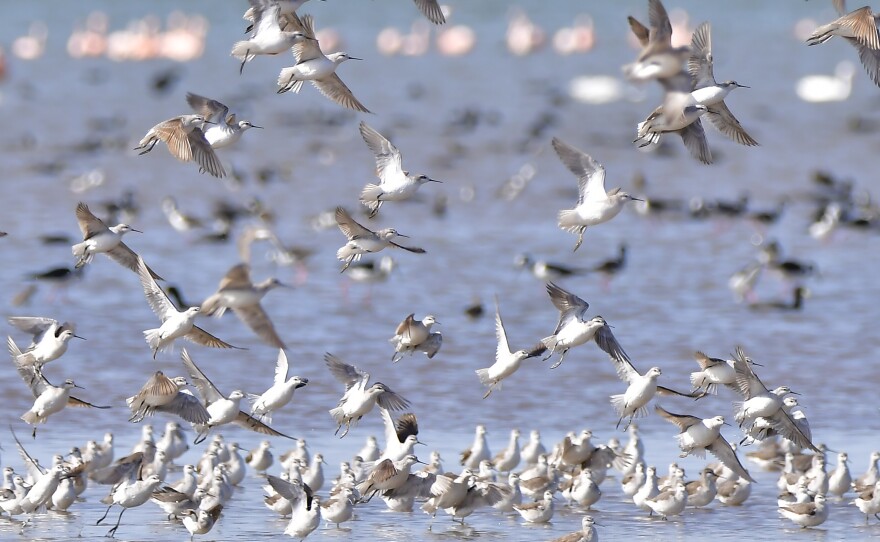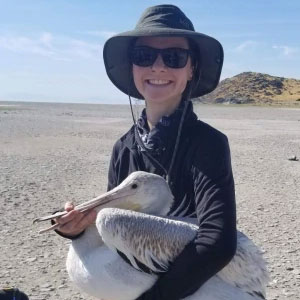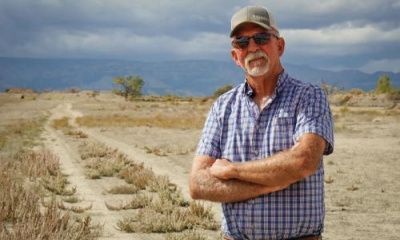Laguna Mar Chiquita is a large saline lake in central Argentina. Much like Great Salt Lake, Mar Chiquita hosts millions of migratory birds each year, and has faced fluctuating water levels, pollution and habitat loss. Agricultural water diversions further threaten future water quality and ecosystem health.
Marcela Castellino is a flyways conservation specialist at the Western Hemisphere Shorebird Reserve Network, or WHSRN. Marcela’s research is focused primarily on a small shorebird species, the Wilson’s phalarope. She said these birds are drawn to saline lakes and the wetlands that surround them and are important ecological indicators.
“This is a species that is very highly adapted to these kinds of wetlands and so they need the unique conditions that they can find in hypersaline lakes…it's very important because they can work as indicators of the health status of the wetland,” Marcela explained.
Wilson’s phalaropes are one of a handful of bird species that migrate between Great Salt Lake and Laguna Mar Chiquita. Unfortunately, as we’ve seen with Utah’s Great Salt Lake, many saline lakes that phalaropes and other shorebirds rely on are facing water level declines and rising salt content across the globe.
“Saline lakes across the world are in danger. There are, like, different threats. Climate change is one of them, but also, water diversion for human activities,” Marcela said. “Many saline lakes are dropping their water levels. So, the salinity is increasing in levels that are higher than the invertebrates that are food for phalaropes and other shorebirds can survive [in].”
Despite ongoing concerns about ecological degradation, those fighting to keep Mar Chiquita’s ecosystem healthy have been able to breathe a recent sigh of relief. In addition to its current designation as a provincial park and national reserve, part of the lake was designated as a national park last year. With the park designation comes additional ecological protections, amid human development and population growth in the area.
As saline lakes continue to shrink globally, environmental protections are critical for these threatened ecosystems. However, Marina Castellino, the executive director of the local NGO, Fundación Líderes de Ansenuza, hopes educating the public about Mar Chiquita can protect the lake above and beyond what park protections can provide.
Marina works closely with Marcela on issues affecting Mar Chiquita. Their relationship, Marcela said, is like family.
“Yeah, she is my sister. It wasn't expected. Completely unexpected. And we ended up working together and it's very nice,” Marcela said.
Marina didn’t start out with the goal of directing an environmental education NGO, but after seeing how powerful educating the public about Mar Chiquita’s issues could be in protecting the lake’s ecosystem, she set off to create an ambitious education program. She worked with WHSRN’s Director, Rob Clay, to get the program up and running.
“I'm a chemical engineer, actually. But then in 2016, I had this crazy idea of starting an educational program on my own for the entire country. So I did it. And it was a leadership program,” Marina explained. “And after a few years, in 2019, I decided to create an NGO in Argentina. And by the end of 2020, Rob Clay from the WHSRN executive office contacted my small NGO in Argentina and he said, ‘I challenge you to create an educational program to support the National Park designation of Mar Chiquita.’”
Environmental education is beneficial to anyone, but Marina said teens are the most rewarding demographic she works with.
Within the program, called Ambientalia Experience, local teens develop projects to help protect Mar Chiquita, and to connect with other local and international researchers. While shorebirds like Wilson’s phalaropes are a major focus, projects also include outreach to embassies within Argentina, beach clean-up, and water sample collection and analysis. Students involved in the program also get leadership training to help hone their outreach skills for the future.
Ambientalia Experience is also reaching past the confines of Argentina to connect students with other saline lakes in the United States.
“This year, something that was very successful was ‘SALT’, that is ‘Saline Educational Learning Teams’. Thanks to Friends of Great Salt Lake, we contacted a group called Latinos In Action from Taylorsville High School. And we decided to do a one-month exchange with our students and their students, so 400 students engage, 200 from each country, in weekly videos,” Marina said.
While SALT is currently only a virtual exchange program, Marina said she wants to create a physical exchange program, where students working at Mar Chiquita can visit Great Salt Lake, and Utah students can visit Mar Chiquita. These connections, Marina argued, are critical to protecting migratory shorebirds and the habitats they rely on.
“We have so many things in common,” Marina said. “Watching them first talking just about, you know, shorebirds and connections and phalaropes, but then also talking about music and phone apps and stuff like that. I think that's important, because migratory shorebirds demand us to be connected. And we need to teach them how to build meaningful connections that go beyond the lakes.”








